Leading Change: An Analysis of Leadership in the Apollo 13 Mission
VerifiedAdded on 2019/12/28
|18
|4411
|290
Report
AI Summary
This report delves into the multifaceted nature of leadership, utilizing Gary Yukl's taxonomy of leadership skills as a foundational framework. It examines the essential qualities of effective leaders, encompassing interpersonal, technical, and conceptual skills. The report centers on the Apollo 13 mission, providing a detailed analysis of Gene Kranz's leadership. Despite the mission's primary objective of landing on the moon being thwarted, the successful return of the astronauts is attributed to Kranz's exceptional leadership. The report dissects his application of technical skills in decision-making, his motivational strategies, and his adeptness at fostering a shared vision among his team. It highlights his ability to handle critical situations, make quick decisions, and empower his team members, which ultimately led to a positive outcome. The report demonstrates how Kranz's leadership style and skills were instrumental in navigating the crisis and ensuring the safe return of the Apollo 13 crew.

LEADING CHANGE
Paraphrase This Document
Need a fresh take? Get an instant paraphrase of this document with our AI Paraphraser
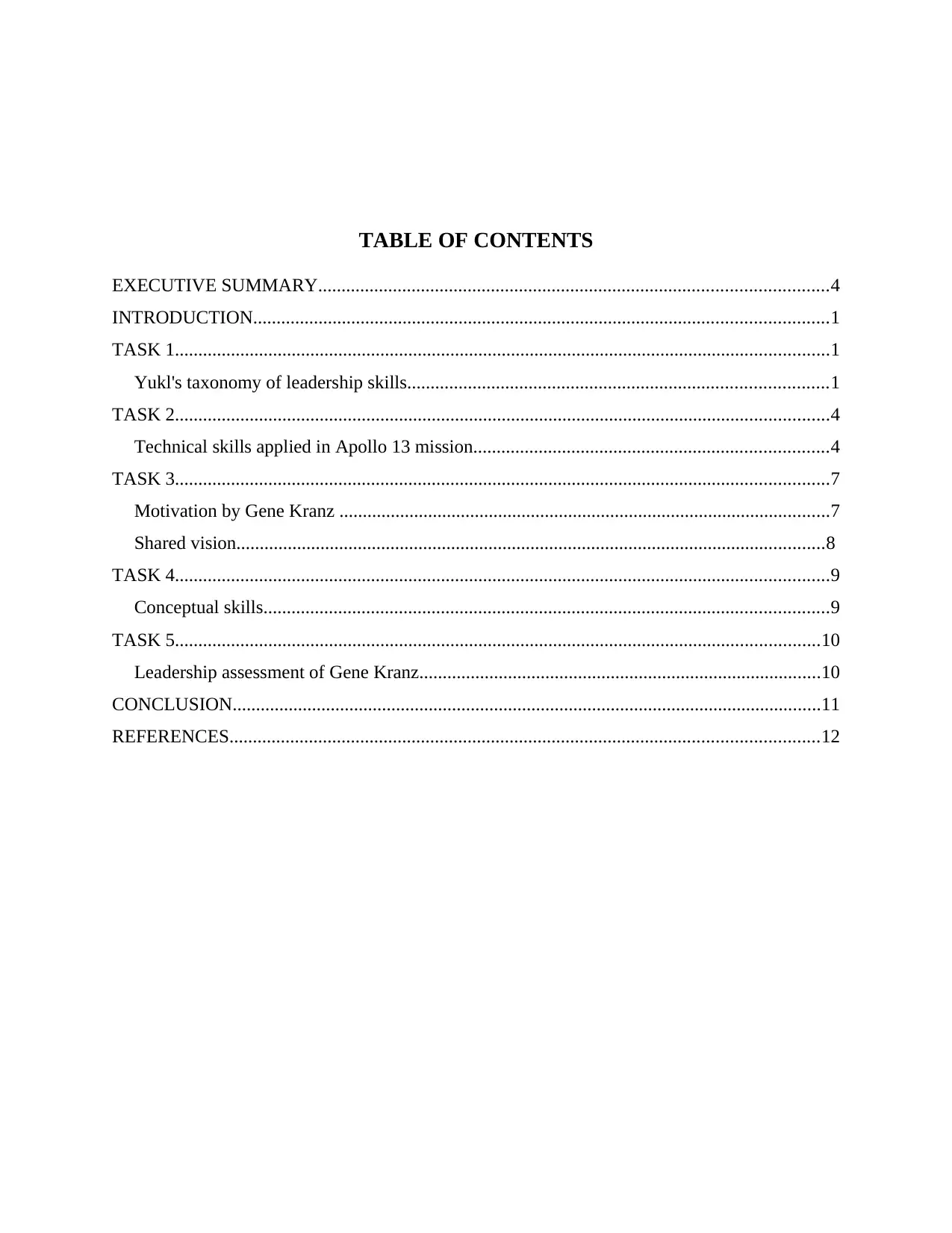
TABLE OF CONTENTS
EXECUTIVE SUMMARY.............................................................................................................4
INTRODUCTION...........................................................................................................................1
TASK 1............................................................................................................................................1
Yukl's taxonomy of leadership skills..........................................................................................1
TASK 2............................................................................................................................................4
Technical skills applied in Apollo 13 mission............................................................................4
TASK 3............................................................................................................................................7
Motivation by Gene Kranz .........................................................................................................7
Shared vision..............................................................................................................................8
TASK 4............................................................................................................................................9
Conceptual skills.........................................................................................................................9
TASK 5..........................................................................................................................................10
Leadership assessment of Gene Kranz......................................................................................10
CONCLUSION..............................................................................................................................11
REFERENCES..............................................................................................................................12
EXECUTIVE SUMMARY.............................................................................................................4
INTRODUCTION...........................................................................................................................1
TASK 1............................................................................................................................................1
Yukl's taxonomy of leadership skills..........................................................................................1
TASK 2............................................................................................................................................4
Technical skills applied in Apollo 13 mission............................................................................4
TASK 3............................................................................................................................................7
Motivation by Gene Kranz .........................................................................................................7
Shared vision..............................................................................................................................8
TASK 4............................................................................................................................................9
Conceptual skills.........................................................................................................................9
TASK 5..........................................................................................................................................10
Leadership assessment of Gene Kranz......................................................................................10
CONCLUSION..............................................................................................................................11
REFERENCES..............................................................................................................................12
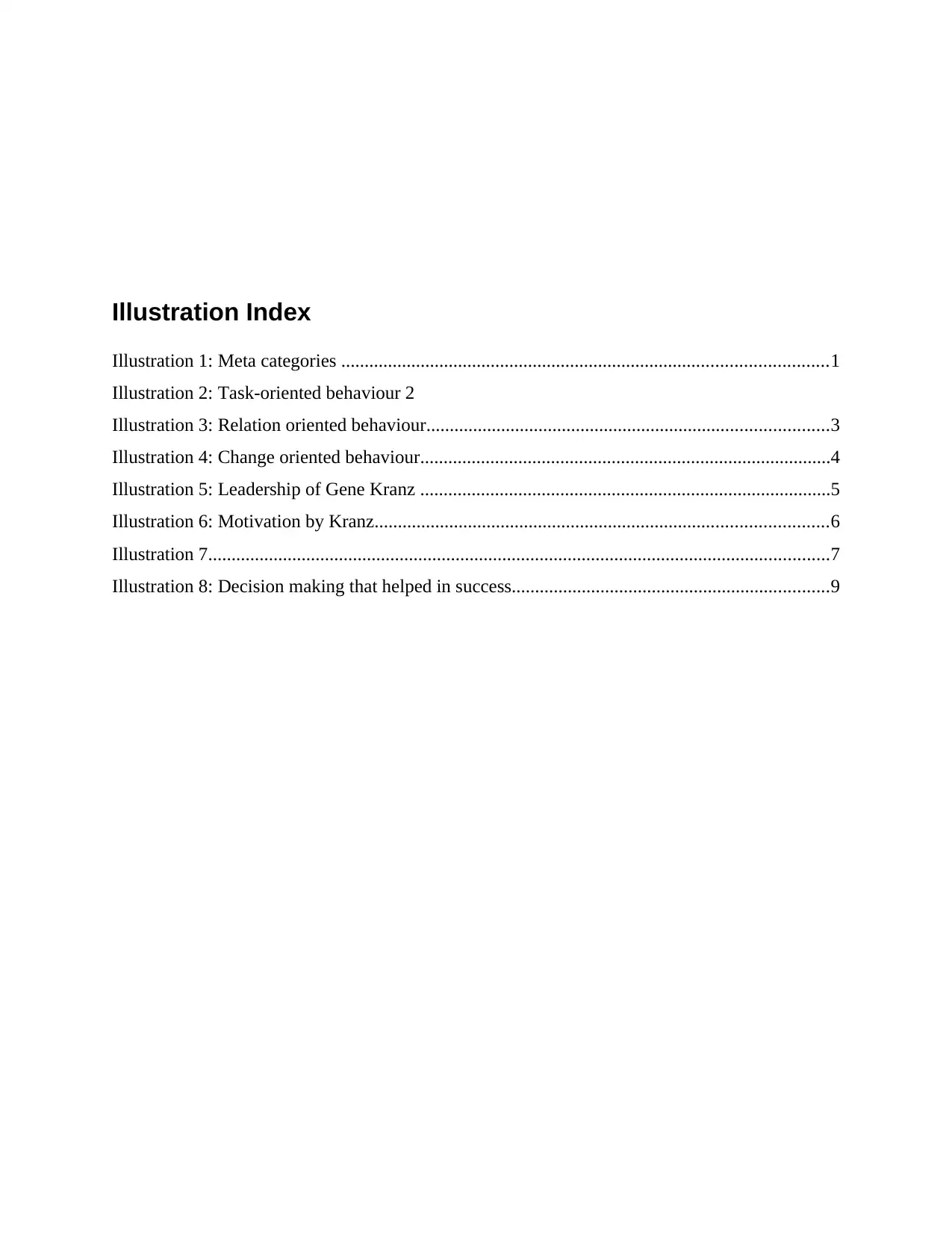
Illustration Index
Illustration 1: Meta categories ........................................................................................................1
Illustration 2: Task-oriented behaviour 2
Illustration 3: Relation oriented behaviour......................................................................................3
Illustration 4: Change oriented behaviour........................................................................................4
Illustration 5: Leadership of Gene Kranz ........................................................................................5
Illustration 6: Motivation by Kranz.................................................................................................6
Illustration 7.....................................................................................................................................7
Illustration 8: Decision making that helped in success....................................................................9
Illustration 1: Meta categories ........................................................................................................1
Illustration 2: Task-oriented behaviour 2
Illustration 3: Relation oriented behaviour......................................................................................3
Illustration 4: Change oriented behaviour........................................................................................4
Illustration 5: Leadership of Gene Kranz ........................................................................................5
Illustration 6: Motivation by Kranz.................................................................................................6
Illustration 7.....................................................................................................................................7
Illustration 8: Decision making that helped in success....................................................................9
⊘ This is a preview!⊘
Do you want full access?
Subscribe today to unlock all pages.

Trusted by 1+ million students worldwide
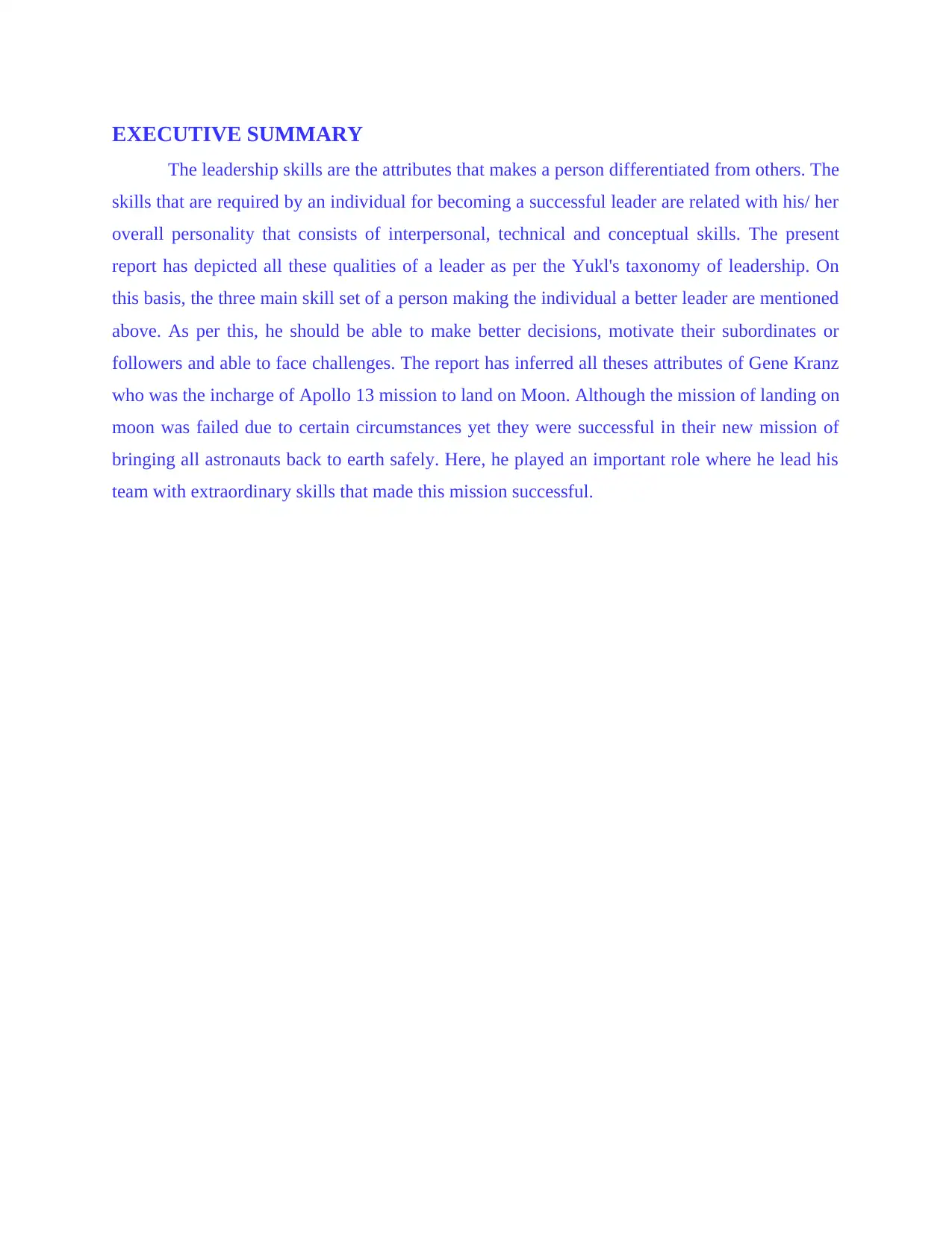
EXECUTIVE SUMMARY
The leadership skills are the attributes that makes a person differentiated from others. The
skills that are required by an individual for becoming a successful leader are related with his/ her
overall personality that consists of interpersonal, technical and conceptual skills. The present
report has depicted all these qualities of a leader as per the Yukl's taxonomy of leadership. On
this basis, the three main skill set of a person making the individual a better leader are mentioned
above. As per this, he should be able to make better decisions, motivate their subordinates or
followers and able to face challenges. The report has inferred all theses attributes of Gene Kranz
who was the incharge of Apollo 13 mission to land on Moon. Although the mission of landing on
moon was failed due to certain circumstances yet they were successful in their new mission of
bringing all astronauts back to earth safely. Here, he played an important role where he lead his
team with extraordinary skills that made this mission successful.
The leadership skills are the attributes that makes a person differentiated from others. The
skills that are required by an individual for becoming a successful leader are related with his/ her
overall personality that consists of interpersonal, technical and conceptual skills. The present
report has depicted all these qualities of a leader as per the Yukl's taxonomy of leadership. On
this basis, the three main skill set of a person making the individual a better leader are mentioned
above. As per this, he should be able to make better decisions, motivate their subordinates or
followers and able to face challenges. The report has inferred all theses attributes of Gene Kranz
who was the incharge of Apollo 13 mission to land on Moon. Although the mission of landing on
moon was failed due to certain circumstances yet they were successful in their new mission of
bringing all astronauts back to earth safely. Here, he played an important role where he lead his
team with extraordinary skills that made this mission successful.
Paraphrase This Document
Need a fresh take? Get an instant paraphrase of this document with our AI Paraphraser
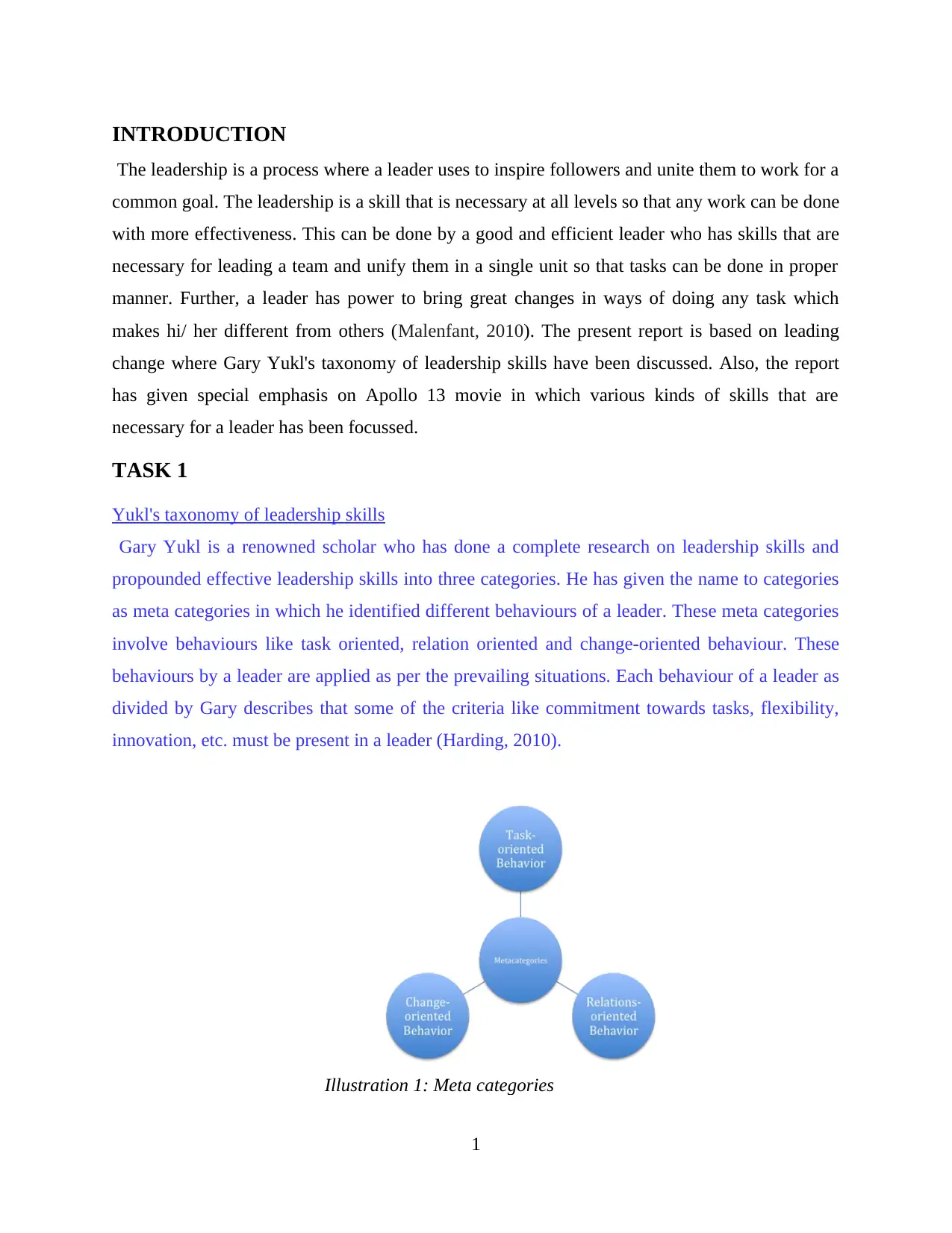
INTRODUCTION
The leadership is a process where a leader uses to inspire followers and unite them to work for a
common goal. The leadership is a skill that is necessary at all levels so that any work can be done
with more effectiveness. This can be done by a good and efficient leader who has skills that are
necessary for leading a team and unify them in a single unit so that tasks can be done in proper
manner. Further, a leader has power to bring great changes in ways of doing any task which
makes hi/ her different from others (Malenfant, 2010). The present report is based on leading
change where Gary Yukl's taxonomy of leadership skills have been discussed. Also, the report
has given special emphasis on Apollo 13 movie in which various kinds of skills that are
necessary for a leader has been focussed.
TASK 1
Yukl's taxonomy of leadership skills
Gary Yukl is a renowned scholar who has done a complete research on leadership skills and
propounded effective leadership skills into three categories. He has given the name to categories
as meta categories in which he identified different behaviours of a leader. These meta categories
involve behaviours like task oriented, relation oriented and change-oriented behaviour. These
behaviours by a leader are applied as per the prevailing situations. Each behaviour of a leader as
divided by Gary describes that some of the criteria like commitment towards tasks, flexibility,
innovation, etc. must be present in a leader (Harding, 2010).
1
Illustration 1: Meta categories
The leadership is a process where a leader uses to inspire followers and unite them to work for a
common goal. The leadership is a skill that is necessary at all levels so that any work can be done
with more effectiveness. This can be done by a good and efficient leader who has skills that are
necessary for leading a team and unify them in a single unit so that tasks can be done in proper
manner. Further, a leader has power to bring great changes in ways of doing any task which
makes hi/ her different from others (Malenfant, 2010). The present report is based on leading
change where Gary Yukl's taxonomy of leadership skills have been discussed. Also, the report
has given special emphasis on Apollo 13 movie in which various kinds of skills that are
necessary for a leader has been focussed.
TASK 1
Yukl's taxonomy of leadership skills
Gary Yukl is a renowned scholar who has done a complete research on leadership skills and
propounded effective leadership skills into three categories. He has given the name to categories
as meta categories in which he identified different behaviours of a leader. These meta categories
involve behaviours like task oriented, relation oriented and change-oriented behaviour. These
behaviours by a leader are applied as per the prevailing situations. Each behaviour of a leader as
divided by Gary describes that some of the criteria like commitment towards tasks, flexibility,
innovation, etc. must be present in a leader (Harding, 2010).
1
Illustration 1: Meta categories
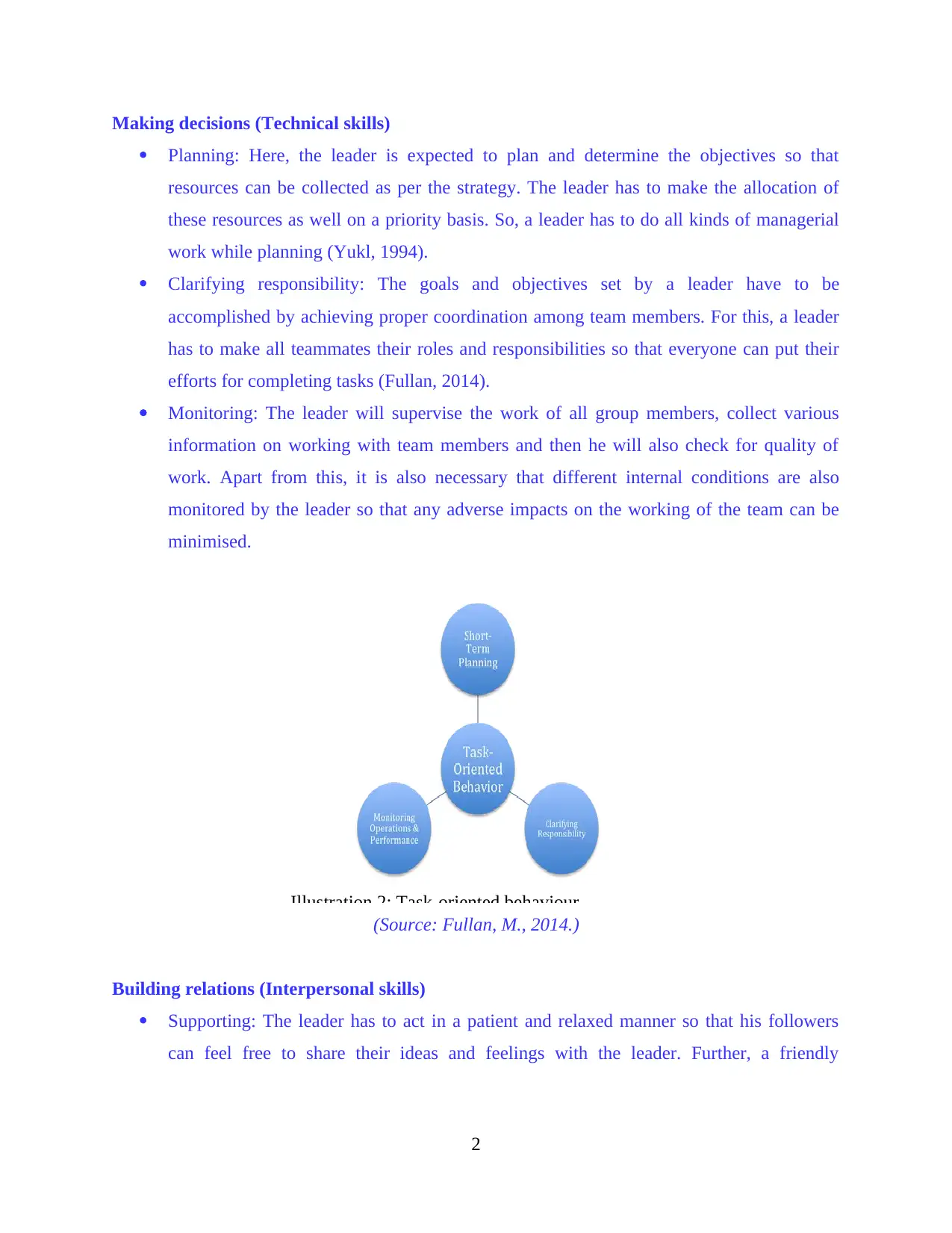
Making decisions (Technical skills)
Planning: Here, the leader is expected to plan and determine the objectives so that
resources can be collected as per the strategy. The leader has to make the allocation of
these resources as well on a priority basis. So, a leader has to do all kinds of managerial
work while planning (Yukl, 1994).
Clarifying responsibility: The goals and objectives set by a leader have to be
accomplished by achieving proper coordination among team members. For this, a leader
has to make all teammates their roles and responsibilities so that everyone can put their
efforts for completing tasks (Fullan, 2014).
Monitoring: The leader will supervise the work of all group members, collect various
information on working with team members and then he will also check for quality of
work. Apart from this, it is also necessary that different internal conditions are also
monitored by the leader so that any adverse impacts on the working of the team can be
minimised.
(Source: Fullan, M., 2014.)
Building relations (Interpersonal skills)
Supporting: The leader has to act in a patient and relaxed manner so that his followers
can feel free to share their ideas and feelings with the leader. Further, a friendly
2
Illustration 2: Task-oriented behaviour
Planning: Here, the leader is expected to plan and determine the objectives so that
resources can be collected as per the strategy. The leader has to make the allocation of
these resources as well on a priority basis. So, a leader has to do all kinds of managerial
work while planning (Yukl, 1994).
Clarifying responsibility: The goals and objectives set by a leader have to be
accomplished by achieving proper coordination among team members. For this, a leader
has to make all teammates their roles and responsibilities so that everyone can put their
efforts for completing tasks (Fullan, 2014).
Monitoring: The leader will supervise the work of all group members, collect various
information on working with team members and then he will also check for quality of
work. Apart from this, it is also necessary that different internal conditions are also
monitored by the leader so that any adverse impacts on the working of the team can be
minimised.
(Source: Fullan, M., 2014.)
Building relations (Interpersonal skills)
Supporting: The leader has to act in a patient and relaxed manner so that his followers
can feel free to share their ideas and feelings with the leader. Further, a friendly
2
Illustration 2: Task-oriented behaviour
⊘ This is a preview!⊘
Do you want full access?
Subscribe today to unlock all pages.

Trusted by 1+ million students worldwide
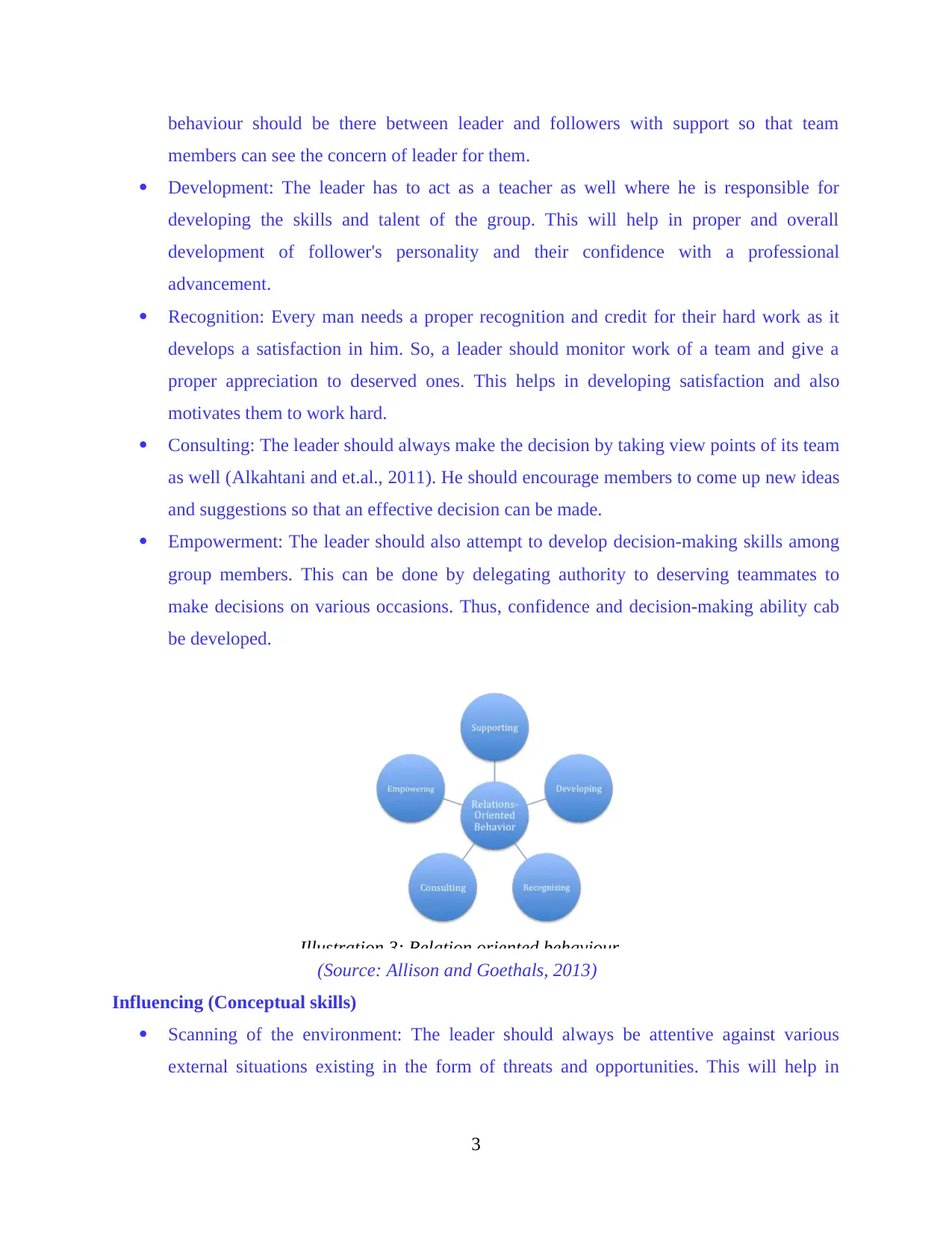
behaviour should be there between leader and followers with support so that team
members can see the concern of leader for them.
Development: The leader has to act as a teacher as well where he is responsible for
developing the skills and talent of the group. This will help in proper and overall
development of follower's personality and their confidence with a professional
advancement.
Recognition: Every man needs a proper recognition and credit for their hard work as it
develops a satisfaction in him. So, a leader should monitor work of a team and give a
proper appreciation to deserved ones. This helps in developing satisfaction and also
motivates them to work hard.
Consulting: The leader should always make the decision by taking view points of its team
as well (Alkahtani and et.al., 2011). He should encourage members to come up new ideas
and suggestions so that an effective decision can be made.
Empowerment: The leader should also attempt to develop decision-making skills among
group members. This can be done by delegating authority to deserving teammates to
make decisions on various occasions. Thus, confidence and decision-making ability cab
be developed.
(Source: Allison and Goethals, 2013)
Influencing (Conceptual skills)
Scanning of the environment: The leader should always be attentive against various
external situations existing in the form of threats and opportunities. This will help in
3
Illustration 3: Relation oriented behaviour
members can see the concern of leader for them.
Development: The leader has to act as a teacher as well where he is responsible for
developing the skills and talent of the group. This will help in proper and overall
development of follower's personality and their confidence with a professional
advancement.
Recognition: Every man needs a proper recognition and credit for their hard work as it
develops a satisfaction in him. So, a leader should monitor work of a team and give a
proper appreciation to deserved ones. This helps in developing satisfaction and also
motivates them to work hard.
Consulting: The leader should always make the decision by taking view points of its team
as well (Alkahtani and et.al., 2011). He should encourage members to come up new ideas
and suggestions so that an effective decision can be made.
Empowerment: The leader should also attempt to develop decision-making skills among
group members. This can be done by delegating authority to deserving teammates to
make decisions on various occasions. Thus, confidence and decision-making ability cab
be developed.
(Source: Allison and Goethals, 2013)
Influencing (Conceptual skills)
Scanning of the environment: The leader should always be attentive against various
external situations existing in the form of threats and opportunities. This will help in
3
Illustration 3: Relation oriented behaviour
Paraphrase This Document
Need a fresh take? Get an instant paraphrase of this document with our AI Paraphraser
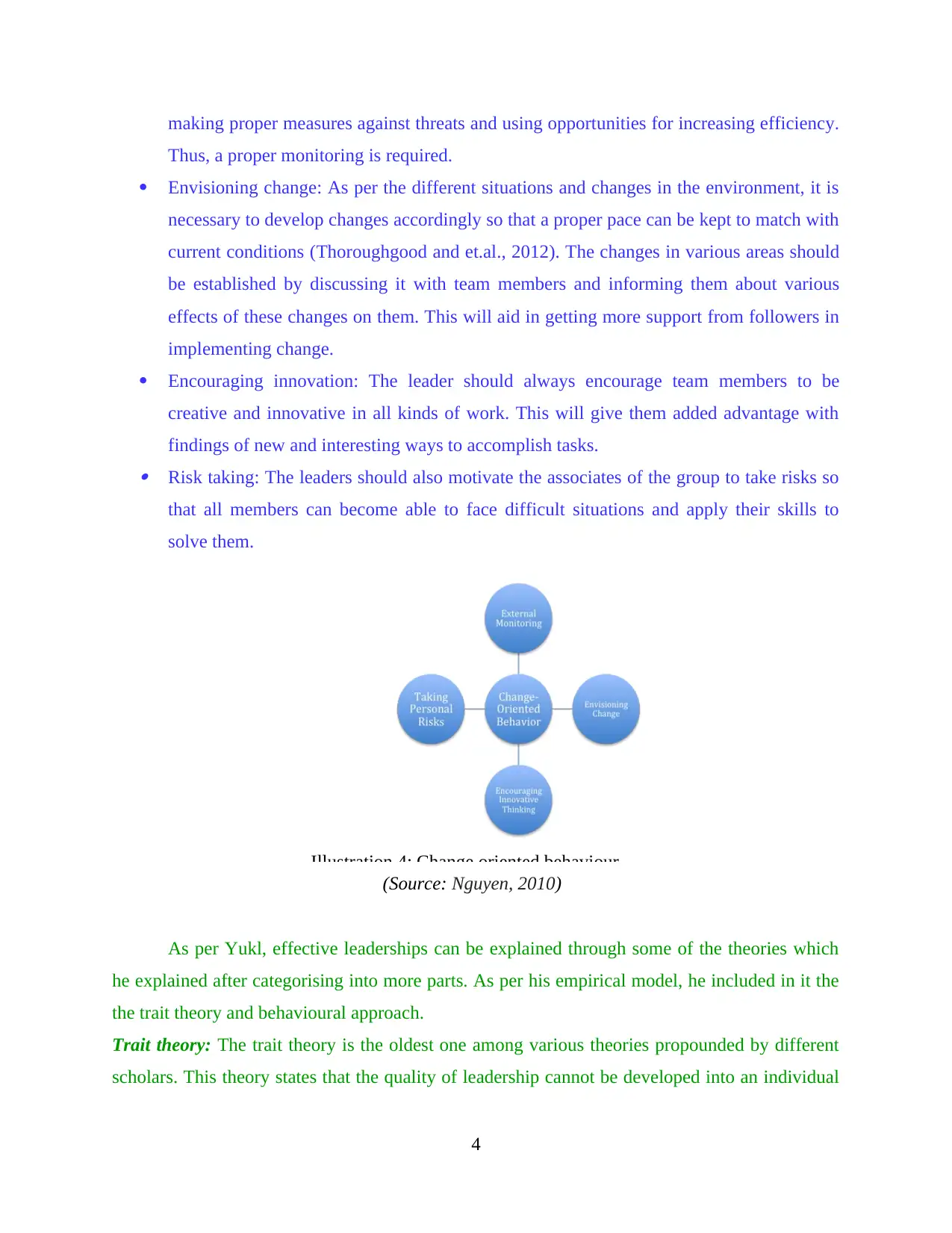
making proper measures against threats and using opportunities for increasing efficiency.
Thus, a proper monitoring is required.
Envisioning change: As per the different situations and changes in the environment, it is
necessary to develop changes accordingly so that a proper pace can be kept to match with
current conditions (Thoroughgood and et.al., 2012). The changes in various areas should
be established by discussing it with team members and informing them about various
effects of these changes on them. This will aid in getting more support from followers in
implementing change.
Encouraging innovation: The leader should always encourage team members to be
creative and innovative in all kinds of work. This will give them added advantage with
findings of new and interesting ways to accomplish tasks. Risk taking: The leaders should also motivate the associates of the group to take risks so
that all members can become able to face difficult situations and apply their skills to
solve them.
(Source: Nguyen, 2010)
As per Yukl, effective leaderships can be explained through some of the theories which
he explained after categorising into more parts. As per his empirical model, he included in it the
the trait theory and behavioural approach.
Trait theory: The trait theory is the oldest one among various theories propounded by different
scholars. This theory states that the quality of leadership cannot be developed into an individual
4
Illustration 4: Change oriented behaviour
Thus, a proper monitoring is required.
Envisioning change: As per the different situations and changes in the environment, it is
necessary to develop changes accordingly so that a proper pace can be kept to match with
current conditions (Thoroughgood and et.al., 2012). The changes in various areas should
be established by discussing it with team members and informing them about various
effects of these changes on them. This will aid in getting more support from followers in
implementing change.
Encouraging innovation: The leader should always encourage team members to be
creative and innovative in all kinds of work. This will give them added advantage with
findings of new and interesting ways to accomplish tasks. Risk taking: The leaders should also motivate the associates of the group to take risks so
that all members can become able to face difficult situations and apply their skills to
solve them.
(Source: Nguyen, 2010)
As per Yukl, effective leaderships can be explained through some of the theories which
he explained after categorising into more parts. As per his empirical model, he included in it the
the trait theory and behavioural approach.
Trait theory: The trait theory is the oldest one among various theories propounded by different
scholars. This theory states that the quality of leadership cannot be developed into an individual
4
Illustration 4: Change oriented behaviour
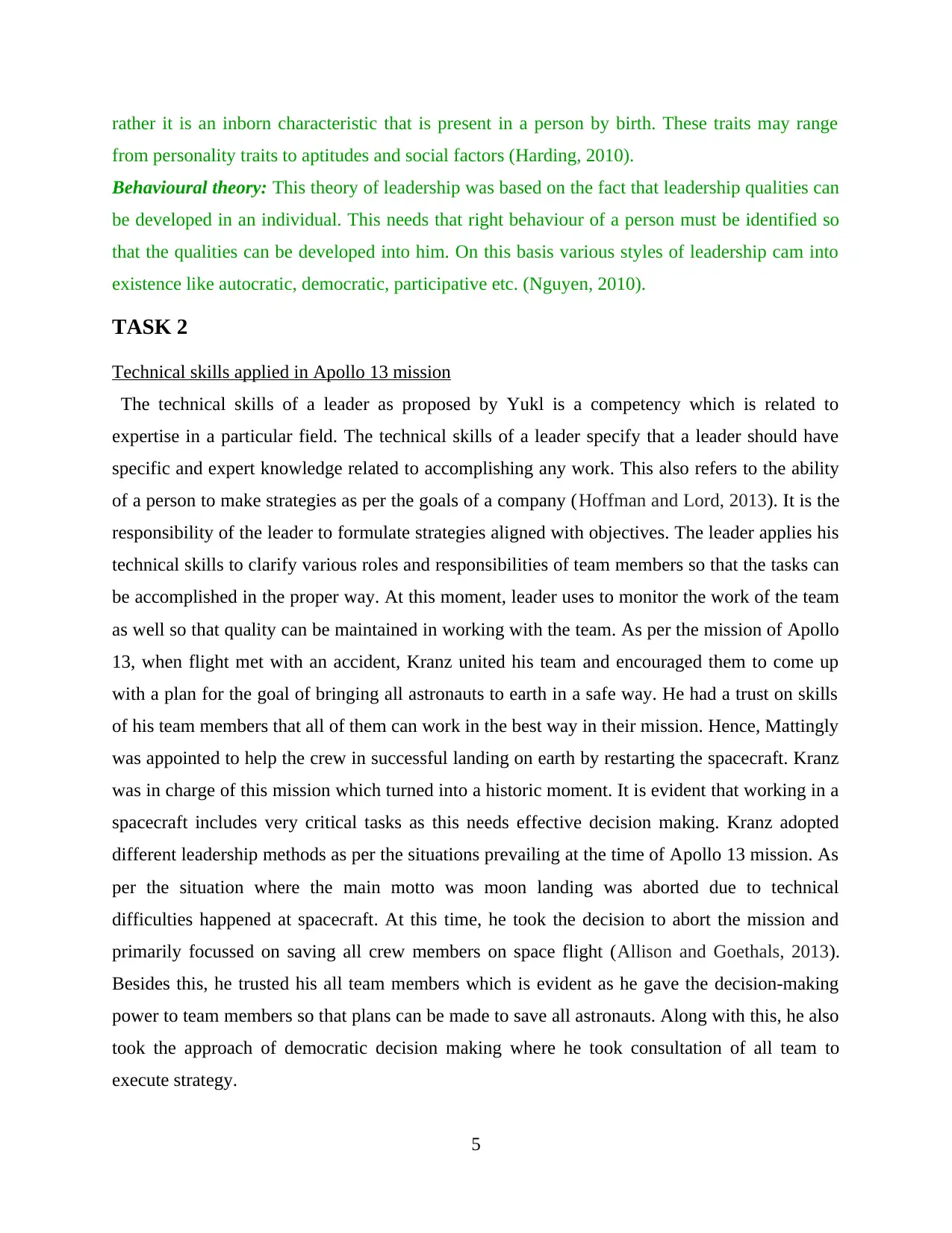
rather it is an inborn characteristic that is present in a person by birth. These traits may range
from personality traits to aptitudes and social factors (Harding, 2010).
Behavioural theory: This theory of leadership was based on the fact that leadership qualities can
be developed in an individual. This needs that right behaviour of a person must be identified so
that the qualities can be developed into him. On this basis various styles of leadership cam into
existence like autocratic, democratic, participative etc. (Nguyen, 2010).
TASK 2
Technical skills applied in Apollo 13 mission
The technical skills of a leader as proposed by Yukl is a competency which is related to
expertise in a particular field. The technical skills of a leader specify that a leader should have
specific and expert knowledge related to accomplishing any work. This also refers to the ability
of a person to make strategies as per the goals of a company (Hoffman and Lord, 2013). It is the
responsibility of the leader to formulate strategies aligned with objectives. The leader applies his
technical skills to clarify various roles and responsibilities of team members so that the tasks can
be accomplished in the proper way. At this moment, leader uses to monitor the work of the team
as well so that quality can be maintained in working with the team. As per the mission of Apollo
13, when flight met with an accident, Kranz united his team and encouraged them to come up
with a plan for the goal of bringing all astronauts to earth in a safe way. He had a trust on skills
of his team members that all of them can work in the best way in their mission. Hence, Mattingly
was appointed to help the crew in successful landing on earth by restarting the spacecraft. Kranz
was in charge of this mission which turned into a historic moment. It is evident that working in a
spacecraft includes very critical tasks as this needs effective decision making. Kranz adopted
different leadership methods as per the situations prevailing at the time of Apollo 13 mission. As
per the situation where the main motto was moon landing was aborted due to technical
difficulties happened at spacecraft. At this time, he took the decision to abort the mission and
primarily focussed on saving all crew members on space flight (Allison and Goethals, 2013).
Besides this, he trusted his all team members which is evident as he gave the decision-making
power to team members so that plans can be made to save all astronauts. Along with this, he also
took the approach of democratic decision making where he took consultation of all team to
execute strategy.
5
from personality traits to aptitudes and social factors (Harding, 2010).
Behavioural theory: This theory of leadership was based on the fact that leadership qualities can
be developed in an individual. This needs that right behaviour of a person must be identified so
that the qualities can be developed into him. On this basis various styles of leadership cam into
existence like autocratic, democratic, participative etc. (Nguyen, 2010).
TASK 2
Technical skills applied in Apollo 13 mission
The technical skills of a leader as proposed by Yukl is a competency which is related to
expertise in a particular field. The technical skills of a leader specify that a leader should have
specific and expert knowledge related to accomplishing any work. This also refers to the ability
of a person to make strategies as per the goals of a company (Hoffman and Lord, 2013). It is the
responsibility of the leader to formulate strategies aligned with objectives. The leader applies his
technical skills to clarify various roles and responsibilities of team members so that the tasks can
be accomplished in the proper way. At this moment, leader uses to monitor the work of the team
as well so that quality can be maintained in working with the team. As per the mission of Apollo
13, when flight met with an accident, Kranz united his team and encouraged them to come up
with a plan for the goal of bringing all astronauts to earth in a safe way. He had a trust on skills
of his team members that all of them can work in the best way in their mission. Hence, Mattingly
was appointed to help the crew in successful landing on earth by restarting the spacecraft. Kranz
was in charge of this mission which turned into a historic moment. It is evident that working in a
spacecraft includes very critical tasks as this needs effective decision making. Kranz adopted
different leadership methods as per the situations prevailing at the time of Apollo 13 mission. As
per the situation where the main motto was moon landing was aborted due to technical
difficulties happened at spacecraft. At this time, he took the decision to abort the mission and
primarily focussed on saving all crew members on space flight (Allison and Goethals, 2013).
Besides this, he trusted his all team members which is evident as he gave the decision-making
power to team members so that plans can be made to save all astronauts. Along with this, he also
took the approach of democratic decision making where he took consultation of all team to
execute strategy.
5
⊘ This is a preview!⊘
Do you want full access?
Subscribe today to unlock all pages.

Trusted by 1+ million students worldwide
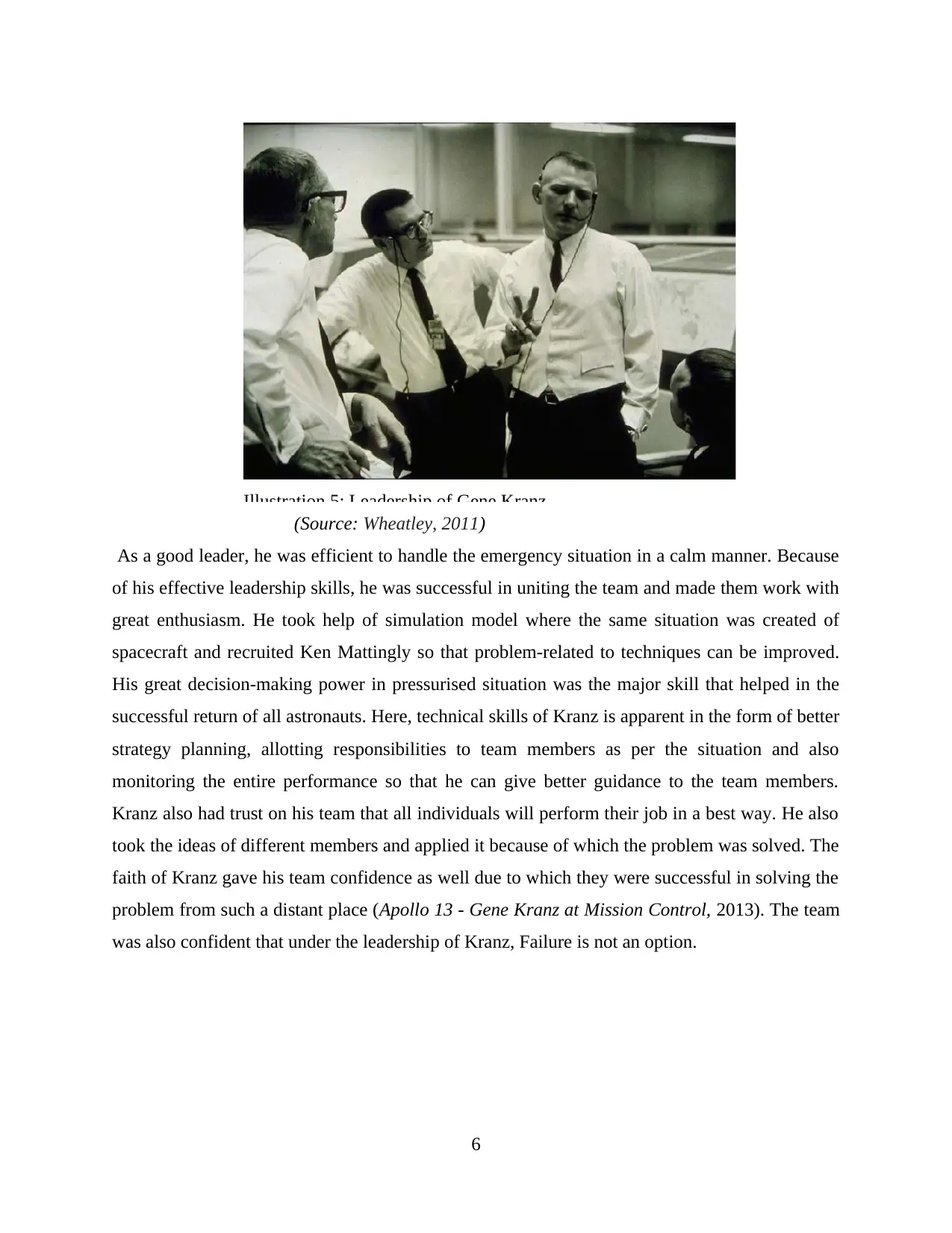
(Source: Wheatley, 2011)
As a good leader, he was efficient to handle the emergency situation in a calm manner. Because
of his effective leadership skills, he was successful in uniting the team and made them work with
great enthusiasm. He took help of simulation model where the same situation was created of
spacecraft and recruited Ken Mattingly so that problem-related to techniques can be improved.
His great decision-making power in pressurised situation was the major skill that helped in the
successful return of all astronauts. Here, technical skills of Kranz is apparent in the form of better
strategy planning, allotting responsibilities to team members as per the situation and also
monitoring the entire performance so that he can give better guidance to the team members.
Kranz also had trust on his team that all individuals will perform their job in a best way. He also
took the ideas of different members and applied it because of which the problem was solved. The
faith of Kranz gave his team confidence as well due to which they were successful in solving the
problem from such a distant place (Apollo 13 - Gene Kranz at Mission Control, 2013). The team
was also confident that under the leadership of Kranz, Failure is not an option.
6
Illustration 5: Leadership of Gene Kranz
As a good leader, he was efficient to handle the emergency situation in a calm manner. Because
of his effective leadership skills, he was successful in uniting the team and made them work with
great enthusiasm. He took help of simulation model where the same situation was created of
spacecraft and recruited Ken Mattingly so that problem-related to techniques can be improved.
His great decision-making power in pressurised situation was the major skill that helped in the
successful return of all astronauts. Here, technical skills of Kranz is apparent in the form of better
strategy planning, allotting responsibilities to team members as per the situation and also
monitoring the entire performance so that he can give better guidance to the team members.
Kranz also had trust on his team that all individuals will perform their job in a best way. He also
took the ideas of different members and applied it because of which the problem was solved. The
faith of Kranz gave his team confidence as well due to which they were successful in solving the
problem from such a distant place (Apollo 13 - Gene Kranz at Mission Control, 2013). The team
was also confident that under the leadership of Kranz, Failure is not an option.
6
Illustration 5: Leadership of Gene Kranz
Paraphrase This Document
Need a fresh take? Get an instant paraphrase of this document with our AI Paraphraser
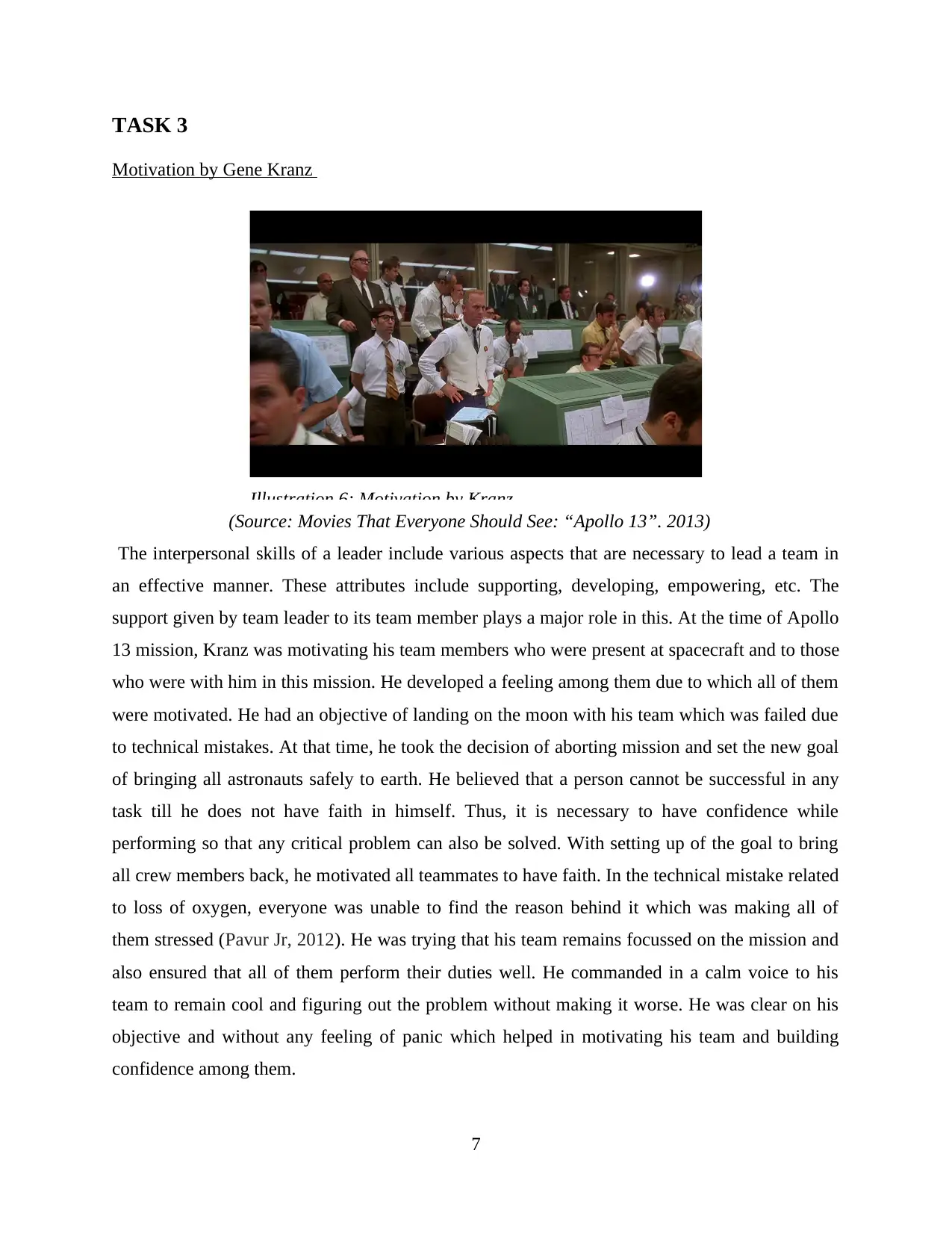
TASK 3
Motivation by Gene Kranz
(Source: Movies That Everyone Should See: “Apollo 13”. 2013)
The interpersonal skills of a leader include various aspects that are necessary to lead a team in
an effective manner. These attributes include supporting, developing, empowering, etc. The
support given by team leader to its team member plays a major role in this. At the time of Apollo
13 mission, Kranz was motivating his team members who were present at spacecraft and to those
who were with him in this mission. He developed a feeling among them due to which all of them
were motivated. He had an objective of landing on the moon with his team which was failed due
to technical mistakes. At that time, he took the decision of aborting mission and set the new goal
of bringing all astronauts safely to earth. He believed that a person cannot be successful in any
task till he does not have faith in himself. Thus, it is necessary to have confidence while
performing so that any critical problem can also be solved. With setting up of the goal to bring
all crew members back, he motivated all teammates to have faith. In the technical mistake related
to loss of oxygen, everyone was unable to find the reason behind it which was making all of
them stressed (Pavur Jr, 2012). He was trying that his team remains focussed on the mission and
also ensured that all of them perform their duties well. He commanded in a calm voice to his
team to remain cool and figuring out the problem without making it worse. He was clear on his
objective and without any feeling of panic which helped in motivating his team and building
confidence among them.
7
Illustration 6: Motivation by Kranz
Motivation by Gene Kranz
(Source: Movies That Everyone Should See: “Apollo 13”. 2013)
The interpersonal skills of a leader include various aspects that are necessary to lead a team in
an effective manner. These attributes include supporting, developing, empowering, etc. The
support given by team leader to its team member plays a major role in this. At the time of Apollo
13 mission, Kranz was motivating his team members who were present at spacecraft and to those
who were with him in this mission. He developed a feeling among them due to which all of them
were motivated. He had an objective of landing on the moon with his team which was failed due
to technical mistakes. At that time, he took the decision of aborting mission and set the new goal
of bringing all astronauts safely to earth. He believed that a person cannot be successful in any
task till he does not have faith in himself. Thus, it is necessary to have confidence while
performing so that any critical problem can also be solved. With setting up of the goal to bring
all crew members back, he motivated all teammates to have faith. In the technical mistake related
to loss of oxygen, everyone was unable to find the reason behind it which was making all of
them stressed (Pavur Jr, 2012). He was trying that his team remains focussed on the mission and
also ensured that all of them perform their duties well. He commanded in a calm voice to his
team to remain cool and figuring out the problem without making it worse. He was clear on his
objective and without any feeling of panic which helped in motivating his team and building
confidence among them.
7
Illustration 6: Motivation by Kranz
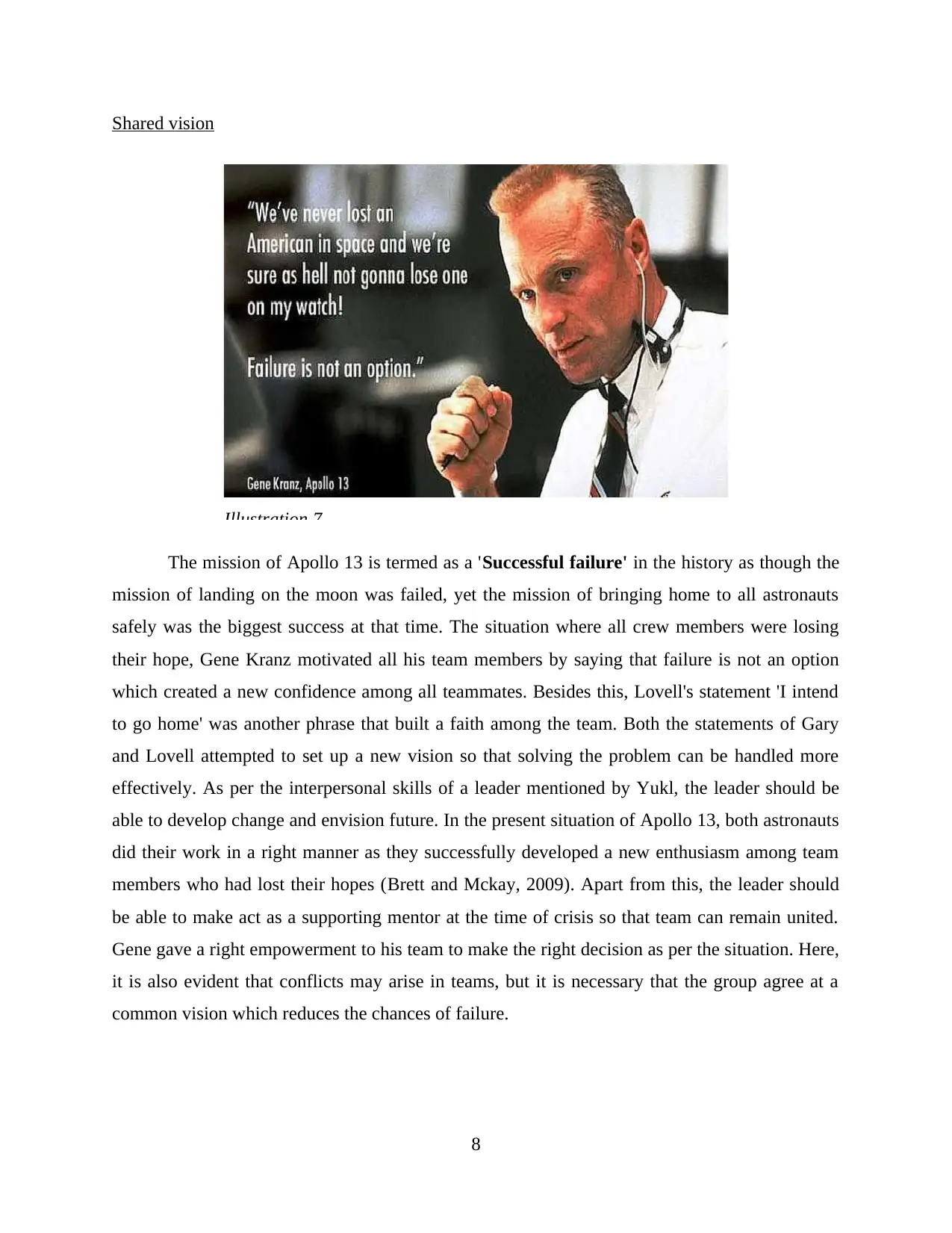
Shared vision
The mission of Apollo 13 is termed as a 'Successful failure' in the history as though the
mission of landing on the moon was failed, yet the mission of bringing home to all astronauts
safely was the biggest success at that time. The situation where all crew members were losing
their hope, Gene Kranz motivated all his team members by saying that failure is not an option
which created a new confidence among all teammates. Besides this, Lovell's statement 'I intend
to go home' was another phrase that built a faith among the team. Both the statements of Gary
and Lovell attempted to set up a new vision so that solving the problem can be handled more
effectively. As per the interpersonal skills of a leader mentioned by Yukl, the leader should be
able to develop change and envision future. In the present situation of Apollo 13, both astronauts
did their work in a right manner as they successfully developed a new enthusiasm among team
members who had lost their hopes (Brett and Mckay, 2009). Apart from this, the leader should
be able to make act as a supporting mentor at the time of crisis so that team can remain united.
Gene gave a right empowerment to his team to make the right decision as per the situation. Here,
it is also evident that conflicts may arise in teams, but it is necessary that the group agree at a
common vision which reduces the chances of failure.
8
Illustration 7
The mission of Apollo 13 is termed as a 'Successful failure' in the history as though the
mission of landing on the moon was failed, yet the mission of bringing home to all astronauts
safely was the biggest success at that time. The situation where all crew members were losing
their hope, Gene Kranz motivated all his team members by saying that failure is not an option
which created a new confidence among all teammates. Besides this, Lovell's statement 'I intend
to go home' was another phrase that built a faith among the team. Both the statements of Gary
and Lovell attempted to set up a new vision so that solving the problem can be handled more
effectively. As per the interpersonal skills of a leader mentioned by Yukl, the leader should be
able to develop change and envision future. In the present situation of Apollo 13, both astronauts
did their work in a right manner as they successfully developed a new enthusiasm among team
members who had lost their hopes (Brett and Mckay, 2009). Apart from this, the leader should
be able to make act as a supporting mentor at the time of crisis so that team can remain united.
Gene gave a right empowerment to his team to make the right decision as per the situation. Here,
it is also evident that conflicts may arise in teams, but it is necessary that the group agree at a
common vision which reduces the chances of failure.
8
Illustration 7
⊘ This is a preview!⊘
Do you want full access?
Subscribe today to unlock all pages.

Trusted by 1+ million students worldwide
1 out of 18
Related Documents
Your All-in-One AI-Powered Toolkit for Academic Success.
+13062052269
info@desklib.com
Available 24*7 on WhatsApp / Email
![[object Object]](/_next/static/media/star-bottom.7253800d.svg)
Unlock your academic potential
Copyright © 2020–2025 A2Z Services. All Rights Reserved. Developed and managed by ZUCOL.





